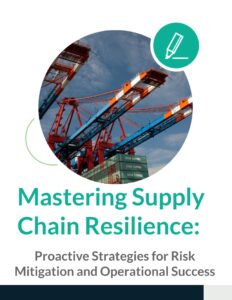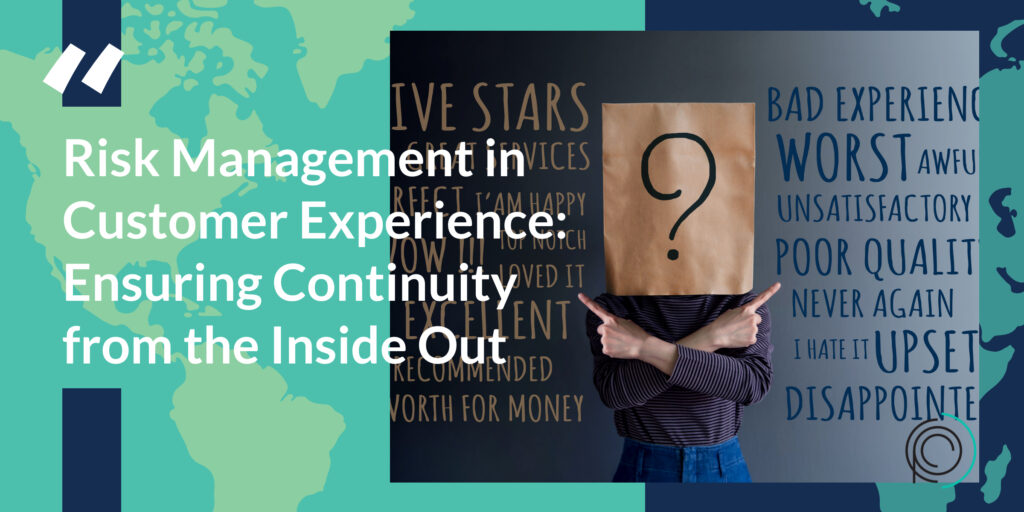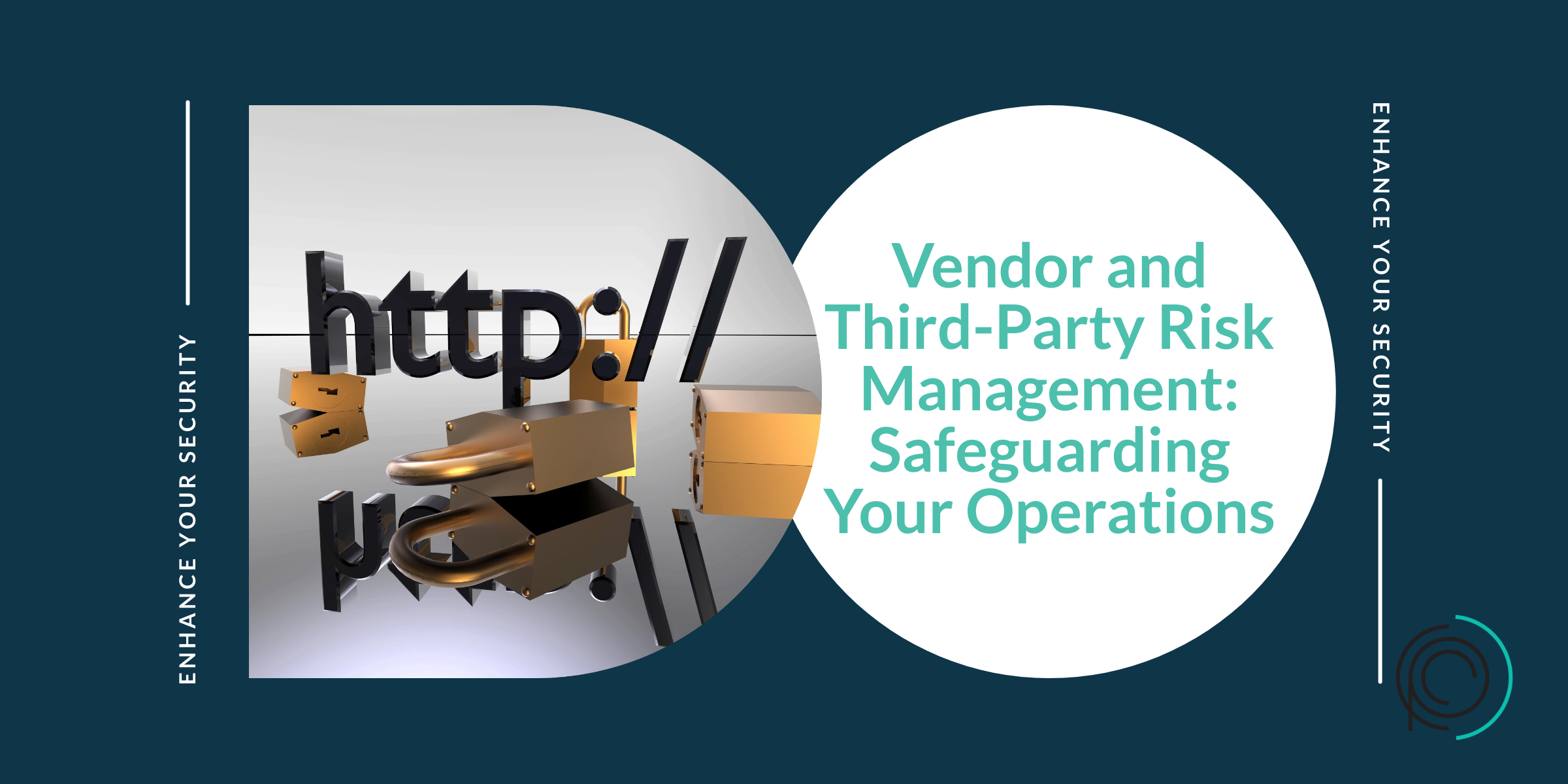Risk Management in Customer Experience: Ensuring Continuity from the Inside Out
Operational risks are akin to hidden icebergs lurking beneath the surface of a business, often unnoticed until they cause significant disruption. These risks can unexpectedly impact the customer experience, leading to dissatisfaction and loss of trust, with potentially severe consequences for the company’s reputation and bottom line. For decision-makers, it is crucial to comprehend how internal operational risks can influence customer satisfaction and overall business performance. This blog post delves deep into the interconnected world of risk management, emphasizing the importance of operational efficiency in delivering exceptional customer experiences. We will explore various types of operational risks, their potential impact on customers, and strategies for mitigating these risks to ensure a seamless interaction between the business and its clientele. By understanding these dynamics, companies can proactively safeguard their operations and enhance customer loyalty.
The Relationship Between Operations and Customer Experience
The Backbone of Customer Interactions
Internal operations form the backbone of any interaction a customer has with a company, influencing every touchpoint from initial inquiries to post-purchase support. When these processes run smoothly, customers enjoy a seamless experience that fosters loyalty and encourages repeat business. However, inefficiencies in these operations can lead to delays, mistakes, and frustration on the customer end, which can quickly tarnish the company’s reputation and customer relationships.
Process Inefficiencies
Slow or disorganized processes can significantly hamper the quality of customer service, negatively impacting the overall experience that customers have with a business. For instance, a sluggish order processing system can lead to frustrating delays in fulfillment, resulting not only in customer dissatisfaction but also in potentially lost sales and revenue. When customers place an order, they expect timely updates and rapid delivery; failure to meet these expectations can lead to increased frustration and abandonment of the purchasing process.
Additionally, a disorganized warehouse can exacerbate these issues, resulting in incorrect shipments where customers receive the wrong products or experience significant wait times for their orders. This not only incurs additional costs for the company due to the need for returns and re-shipments but also diminishes customer trust. Customers who receive the wrong items may find it challenging to rectify the situation, leading to a feeling of helplessness and further dissatisfaction.
Such inefficiencies not only frustrate customers but can also erode their trust in the company’s ability to deliver on its promises. When customers feel that a company cannot meet their needs or expectations, they are more likely to seek alternatives, ultimately hurting the company’s reputation and bottom line. At a time in business where customer loyalty is hard-won and easily lost, addressing process inefficiencies is critical for businesses aiming to thrive and maintain a loyal customer base.
Data Management Issues
Errors in data handling can create significant chaos in customer orders, billing, and communications, severely disrupting the flow of information that is critical to maintaining strong and healthy customer relationships. For instance, incorrect customer information, such as misspelled names or outdated contact details, can lead to missed orders or billing errors. These mistakes not only frustrate customers but can also result in confusion, as customers may not receive timely notifications regarding their orders or may be charged incorrectly.
This situation not only leads to a poor customer experience but can also have long-lasting negative effects on the brand’s reputation. Over time, consistent data mishandling can cause customers to lose trust in the business, prompting them to turn to competitors who offer a more reliable experience.
Effective data management is, therefore, essential for maintaining accurate and reliable customer interactions. This involves implementing a series of best practices, including regular audits of data to catch and correct errors, timely updates to ensure that the information remains current, and comprehensive training for staff. Ensuring that employees understand the importance of data integrity is crucial, as it helps uphold quality throughout all processes. Ultimately, a robust data management strategy not only enhances operational efficiency but also fosters positive customer relationships, driving loyalty and long-term success for the business.
Supply Chain Disruptions
Supply chain disruptions can cause significant delays or inconsistencies in delivering products and services, which can severely impact customer satisfaction and loyalty. When items are not delivered on time, customers may feel compelled to turn to competitors who can meet their needs more reliably, leading to a potential loss of business and damage to a brand’s reputation. It’s crucial for decision-makers to ensure that their supply chain is resilient and capable of handling unexpected disruptions, such as natural disasters, geopolitical tensions, or material shortages, which can arise without warning.
To build a robust supply chain, companies should focus on several key strategies. This can involve cultivating strong relationships with suppliers to foster open communication and collaboration. By working closely together, companies can negotiate better terms and ensure that they are prioritized during times of scarcity. Additionally, diversifying sourcing options is essential; relying on a single supplier can be risky, so identifying multiple suppliers across different regions can help mitigate risks associated with disruptions in one area.
Furthermore, implementing comprehensive contingency plans is vital. These plans should outline procedures for maintaining operations even when challenges arise, prioritizing customer satisfaction at every step. This can include strategies such as alternative shipping routes, backup inventory sources, or even emergency partnerships with local businesses to fulfill customer needs. By addressing supply chain vulnerabilities proactively and equipping themselves with the tools to adapt, companies can better serve their customers, ensure consistent product availability, and maintain a competitive edge in the market, even in the face of adversity.
Identifying Internal Risks That Affect Customers
Technology Failures
Technology failures can cripple customer-facing systems, leading to significant downtime and frustrating glitches. For instance, when a website crashes during peak shopping hours or a payment system fails at the checkout, customers are left frustrated and unable to complete their transactions. This can result in lost sales and a negative impression of the brand. Investing in a reliable technology infrastructure, including regular maintenance and updates, is critical to minimizing these occurrences. Additionally, having contingency plans and backup systems in place can ensure that businesses can quickly recover from any technological setbacks, thus safeguarding the customer experience.
Human Errors
Mistakes made in processing orders, responding to inquiries, or fulfilling services can have a profound negative impact on customers and businesses alike. A single error in an order—such as sending the wrong item, failing to meet a promised delivery date, or providing incorrect information—can lead to a cascade of customer complaints, dissatisfaction, and ultimately lost loyalty. These errors can stem from various factors, including a lack of attention to detail, poor communication between team members, or insufficient training on systems and processes.
For example, when an employee is not fully trained on the order management system, they may inadvertently select the wrong product or overlook critical details required for timely delivery. Such mistakes not only inconvenience the customer but also result in additional costs for the company due to returns, refunds, and the need for expedited shipping to rectify the situation.
Implementing robust training programs for employees is essential in helping to minimize these errors and enhance customer satisfaction. Comprehensive training should cover not only the technical aspects of their roles but also emphasize the importance of customer service skills, effective communication, and attention to detail. Regular feedback and performance reviews can also help identify specific areas for improvement, ensuring that employees are well-equipped to deliver excellent service consistently. Encouraging a culture of open communication and continuous learning can further empower staff to seek clarification and support when needed, ultimately fostering a more reliable and customer-focused environment.
Inconsistent Service Quality
Operational bottlenecks or resource constraints can lead to inconsistent service quality, which is detrimental to customer satisfaction. When customers receive varying levels of service—such as differing wait times, product availability, or staff responsiveness—it erodes their trust in the company and can ultimately drive them to competitors. This inconsistency can stem from various factors, including inadequate staffing, unclear procedures, or a lack of coordination among teams, all of which can create frustration for both employees and customers.
For instance, if a restaurant is short-staffed during peak hours, patrons might experience significantly longer wait times for their meals, which can affect their overall dining experience. Similarly, if a retail store frequently runs out of popular items, customers may feel disappointed and less likely to return. To combat these issues, streamlining operations and ensuring that adequate resources are available is crucial for maintaining consistent service quality across all customer touchpoints.
Implementing performance metrics, such as customer feedback scores and response times, along with regular assessments of staff performance and operational efficiency, can also aid in identifying problem areas. By analyzing this data, businesses can make informed adjustments, whether it be through additional training for employees, refining procedures, or improving communication between teams. These proactive measures ensure a reliable and enjoyable experience for all customers, fostering loyalty and enhancing the overall reputation of the business.
Proactive Risk Management for Better Customer Outcomes
Process Optimization
Refining internal workflows to reduce delays, errors, and inconsistencies is key to managing risks proactively. A systematic approach to regularly reviewing and improving processes can significantly enhance efficiency and effectiveness, helping to identify and address potential issues before they impact customers. By leveraging operational excellence methodologies organizations can implement data-driven strategies that not only streamline operations but also foster a culture of continuous improvement. This proactive stance allows companies to adapt to changes in customer demands and market dynamics while ensuring high-quality service delivery.
Technology Upgrades
Investing in reliable, scalable systems is essential for minimizing downtime and enhancing customer interactions. Upgrading technology infrastructure can prevent failures and ensure that customer-facing systems operate smoothly and efficiently. Technology like cloud computing and advanced analytics are invaluable, providing the scalability and reliability necessary for modern businesses. These upgrades not only improve operational resilience but also empower organizations to harness data insights that can lead to better decision-making and more personalized customer experiences.
Employee Training
Ensuring that customer-facing teams are well-trained to handle issues and mitigate service disruptions is crucial for maintaining high customer satisfaction. Continuous training programs are essential for equipping employees with the latest skills, knowledge, and best practices needed to provide exceptional service. Incorporating role-playing scenarios, interactive workshops, and regular feedback sessions can significantly enhance their ability to manage customer interactions effectively. Moreover, fostering a learning environment where employees feel encouraged to share experiences and solutions can lead to a more empowered workforce, ultimately benefiting customer relations and business performance.
Aligning Risk Management with Customer Experience Goals
Cross-Functional Collaboration
Ensuring that operations, risk, and customer experience teams work together is vital for aligning risk management efforts with broader customer experience objectives. When these teams collaborate, they can share insights and competencies that enhance the overall strategy, leading to more effective identification and mitigation of risks. Regular cross-functional meetings provide a platform for open communication, allowing team members to discuss challenges and brainstorm solutions. Additionally, forming integrated project teams that bring together representatives from various functions can facilitate a more cohesive approach to risk management, ultimately leading to a more seamless customer experience.
Monitoring Customer Feedback
Utilizing customer feedback as a tool to identify risks that may not be apparent internally is an invaluable strategy for organizations. Customers often provide insights that internal teams may overlook, as they experience the product or service firsthand. Analyzing customer complaints, suggestions, and general feedback can reveal underlying issues that need addressing. Establishing feedback loops where customer insights are regularly collected, reviewed, and acted upon not only helps in identifying potential risks but also fosters a culture of responsiveness and adaptability within the organization. By prioritizing customer feedback, businesses can drive continuous improvement and enhance their overall service quality.
Continuous Improvement
Creating a robust feedback loop aimed at addressing operational risks that impact customer experience is essential for long-term success. Continuous improvement frameworks, such as Kaizen, focus on incremental changes that lead to significant enhancements over time. These methodologies encourage organizations to systematically assess their processes and identify areas for improvement. Regularly reviewing performance metrics—such as customer satisfaction scores, response times, and complaint resolution rates—combined with actionable feedback from customers, can guide organizations in making informed adjustments. By implementing changes based on this comprehensive analysis, organizations can significantly enhance overall customer satisfaction and loyalty, positioning themselves for sustained growth in a competitive marketplace.
Conclusion
Managing operational risks is not just about protecting the business; it’s about ensuring a strong, consistent customer experience. By understanding the relationship between internal operations and customer interactions, identifying key risks, and implementing proactive strategies, businesses can significantly enhance customer satisfaction.
Decision-makers should regularly review their internal processes for risks that could disrupt their service to customers. By doing so, they can build a resilient operation that not only meets but exceeds customer expectations.
Invest in risk management today to pave the way for a better customer experience tomorrow. For more insights and tailored advice, reach out to our experts who can help you refine your risk management strategies and align them with your customer experience goals.






